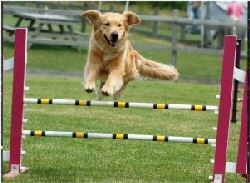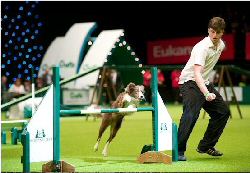|
Co-sponsors of the 2023 Winning Out
Certificates



| |
What are the stresses and strains...
 Dog agility clearly provides
huge benefits for dogs, such as increased cardiovascular fitness, musculoskeletal strength,
flexibility, weight control and mental stimulation, not to mention the fitness dog owners
benefit from by running with them! However, intensive exercise with lots of twisting, turning,
jumping and landing presents a challenge to a dog’s joints as well as a drain on energy
resources. We asked vet James Howie of Lintbell's to explain more about the most common
injuries in dog agility? Dog agility clearly provides
huge benefits for dogs, such as increased cardiovascular fitness, musculoskeletal strength,
flexibility, weight control and mental stimulation, not to mention the fitness dog owners
benefit from by running with them! However, intensive exercise with lots of twisting, turning,
jumping and landing presents a challenge to a dog’s joints as well as a drain on energy
resources. We asked vet James Howie of Lintbell's to explain more about the most common
injuries in dog agility?
Sporting
dogs are predisposed to a variety of injuries that mostly relate to the type of activity they
are involved with. This activity puts increased strain on their muscles, bones and ligaments.
This is especially true if they have been out of action or condition for a while.
A recent
study tried to identify the risk factors and the anatomical sites most commonly injured in
agility dogs. Of the 1627 dogs included in the study, 33% were injured, and of those 58% were
injured in competition*. For example, trauma following jumping from an obstacle may
overextend the carpal joint (equivalent of the wrist joint) as the dog lands. This may cause
ligament damage or even joint damage to the bones or supporting structures. Sudden twists and
turns may damage the collateral ligaments of a joint, for example the stifle or carpal joint.
Overstressed or exhausted muscles may be more prone to tears or sprains, and repeated jumping
and landing can predispose dogs to cruciate ligament damage in the stifle (knee) joint.
What can I do to help my dog’s joints?
Intensive exercise that is associated with dog agility undoubtedly puts strain on joints
and supporting structures like ligaments and tendons. Before embarking on an agility programme
be sure that that your dog is physically capable of the tasks it will need to complete.
On the
day, before the event, take your dog for a walk that lasts 20 minutes or longer. In these 20
minutes, try to make sure your dog has the opportunity to run and play. It is also important to
stretch your dog's muscles after.
You should
start your dog at a low intensity level, before building up to more intensive training. If
competing regularly in agility, wear and tear can become a factor.
You can
help by giving your dog a joint supplement such as
YUMOVE, which contains Hyaluronic Acid.
This acts like a shock absorber in the joint. Glucosamine and Chondroitin may help with the
structure of the cartilage, and Green Lipped Mussel (GLM) contains potent Omega-3s which can
reduce inflammation. The Omega-3s EPA and ETA, found in GLM, can also reduce the effect of
enzymes that breakdown cartilage. Manganese is an important component in connective tissue
structure (tendons, ligaments etc.). YUMOVE is a clinically proven triple action formulation
that combines all of these ingredients to help with joint mobility in just six weeks.
 What about energy levels? What about energy levels?
Intensive exercise results in rapid depletion of
energy stores. During a competition your dog is often required to perform intensive exercise,
rest, and then perform again shortly afterwards. This often leaves the muscles short of the
energy store glycogen.
Simply
giving glucose or fructose orally to a dog after exercise can result in diarrhoea, as fluids
are drawn in to the gut by the high sugar content (osmotic diarrhoea.) This can lead to
dehydration. YUM Energy contains an energy source called Maltodextrins which are rapidly taken
up by the muscle within 30 minutes after exercise, helping them to stay fresh & focussed, and
perform better through the day. These do not cause osmotic diarrhoea.
What about giving them water after exercise?
Rehydrating after exercise is important for two
reasons:-
Do I need to give them electrolytes as well?
Dogs do not sweat sufficiently to need to replace
the electrolytes that would be lost this way in humans. If diarrhoea develops post-exercise, it
would be beneficial to use an electrolyte replacer suitable for dogs.
*
Levy M, Hall C, Trentacosta N, Percival M: A preliminary retrospective survey of injuries
 About the author... About the author...
James Howie BvetMed is the Veterinary Director at Lintbells Ltd. James qualified
from the Royal Veterinary College, London in 2000. Since then he has spent 14 years in mixed
and small animal practice, including working in Morocco, Thailand and New Zealand.
For more
information and advice, please contact Lintbells on 01462 790886 or email
info@lintbells.com
First
published 16 July 2014
| |
|